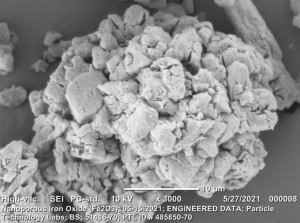
Missile X-Ray Shielding Research leads to Disruptive Particle Suspension Discovery
Discovery Disrupts the Prevailing Theory that Nanoscale, Solid, Similarly-Sized Particles are best suited for Suspension Applications
Nikon’s CT scans challenge the prevailing theory that small nanoscale particles are best suited for Suspension Applications given their small size & reduced weight that slows gravity-induced sedimentation. Despite their small size & light weight, nanoscale particles are still solid grains with asymmetrically round exterior surfaces.
Comparatively, the nanoporous particles tested were large (micron scale), non-solid (due to porosity), and heterogeneous (grain sizes range up to 47,000X greater than nanoparticles tested). Being non-solid rendered the nanoporous particles less dense than nanoparticles. For larger nanoporous particles with interior facing pore networks, to the extent the particle’s interior pores were sealed-off from the suspension fluid, sealed pores aggregately created air pocket cavities which created particle buoyancy. Larger nanoporous particles were theorized to be more buoyant than smaller ones due to greater internal pore cavity volume. Moreover, unlike nanoparticles with smooth rounded exteriors, nanoporous particles displayed exteriors that were both multifaced + multiplanar, generating increased drag resistance as the particle moved through the suspension fluid, slowing, stalling, and even reversing (when buoyancy becomes relevant) sedimentation.
This discovery was an unanticipated byproduct of a Whitepaper Proposal in response to US Missile Defense Agency BAA #HQ0860-23-S-001, where nanoporous & nanoscale powdered Ferric Oxide composite samples were being evaluated as possible lightweight X-Ray shielding alternatives to lead. As of Press Release date, this research is ongoing.
This Suspension Discovery builds off of Synthetic-Metals.com’s July 2023 Performance Tuning breakthrough enabling Ferric Oxide Grain Sizes & Surface areas to be tailored to specific applications, signaling the end of “1 size fits all” Powdered Metal Oxide Raw Materials Manufacturing. For more information, go to https://www.synthetic-metals.com.
Tim Rolf
Engineered Data LLC
+1 202-716-9400
email us here
Visit us on social media:
YouTube
Disruptive Particle Suspension Discovery
EIN Presswire does not exercise editorial control over third-party content provided, uploaded, published, or distributed by users of EIN Presswire. We are a distributor, not a publisher, of 3rd party content. Such content may contain the views, opinions, statements, offers, and other material of the respective users, suppliers, participants, or authors.




